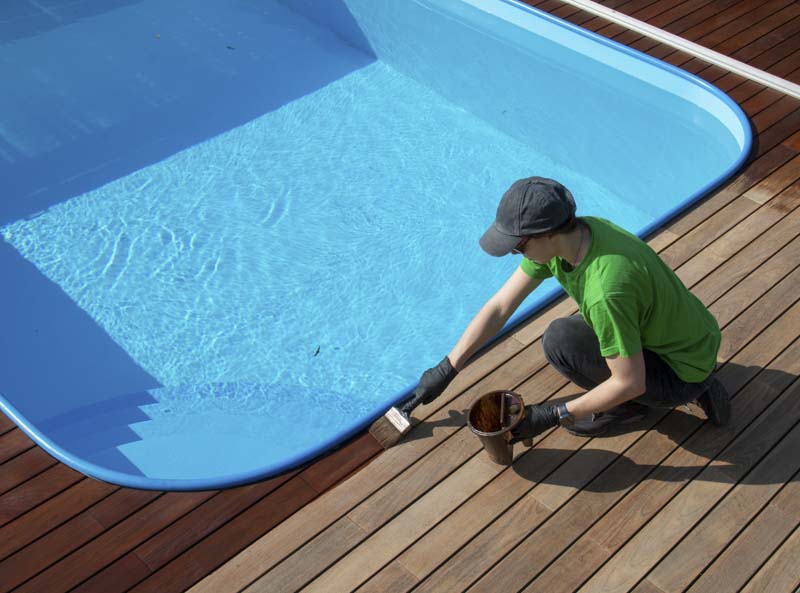Waterproofing the wood around your home prevents it from aging and helps it maintain its natural beauty. Learn how to waterproof wood and keep your projects looking great with these helpful tips and techniques.
Why Waterproofing Wood is Important
There’s a considerable difference between wood that has been waterproofed and wood that has been allowed to absorb moisture and soak up UV rays. Weatherproofing wood prevents moisture damage, makes your projects last longer, and enhances their appearance.
Prevents Moisture Damage
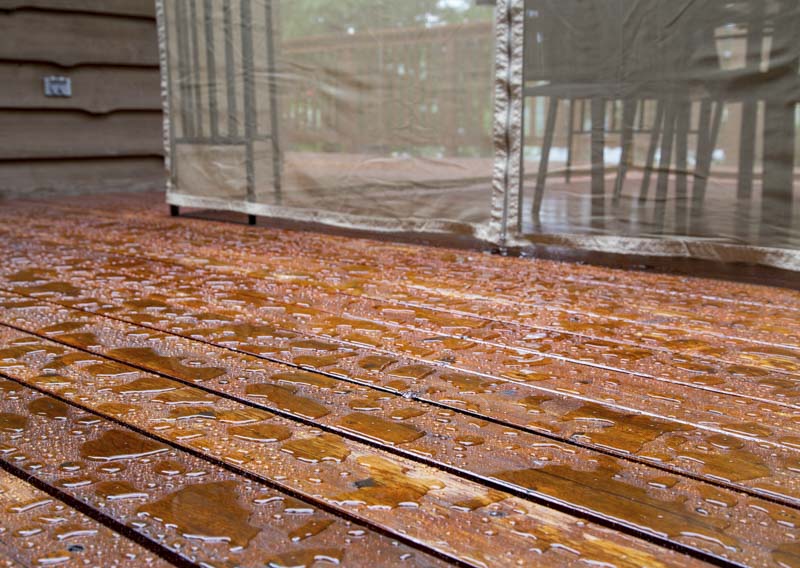
Wood is porous, and without a protective coating, it absorbs moisture easily. Once moisture enters the wood pores, it leads to swelling, warping, and decay.
Applying a waterproof barrier to wood keeps moisture out, protecting it from the damaging effects of humidity and rain. Waterproofing wood safeguards the integrity of the wood, ensuring that your projects maintain their intended shape.
Increases Longevity
Waterproofing wood makes it last longer. For example, one of the most water-resistant wood types is oak. It’s naturally more resistant to moisture and UV rays, but constant expansion and contraction of the fibers due to heat, moisture, and UV rays compromise its structure. Over time, even oak loses strength and aesthetic appeal and eventually decays.
Projects exposed to the elements, such as your deck, wood fencing, and outdoor furniture, are more vulnerable without waterproof coatings. Unprotected wood is also more likely to succumb to insect infestations, moss, algae, and mold growth.
Enhances Aesthetics
Waterproofing wood is more than just practical. When wood ages gracefully, it has a classic, timeless appeal. Wood that has been allowed to weather and decay is less appealing than wood that has been protected to preserve its natural beauty.
When you protect wood from water, it creates a barrier that helps it resist discoloration and fading, and it’s less likely to develop cracks and deterioration that take away from its appearance. It can maintain an unblemished, smooth surface for much longer.
Benefits of Waterproofing Wood
In addition to preserving its beauty and protecting it from moisture damage, waterproofing wood has a few other benefits.
Protection Against Rot and Decay
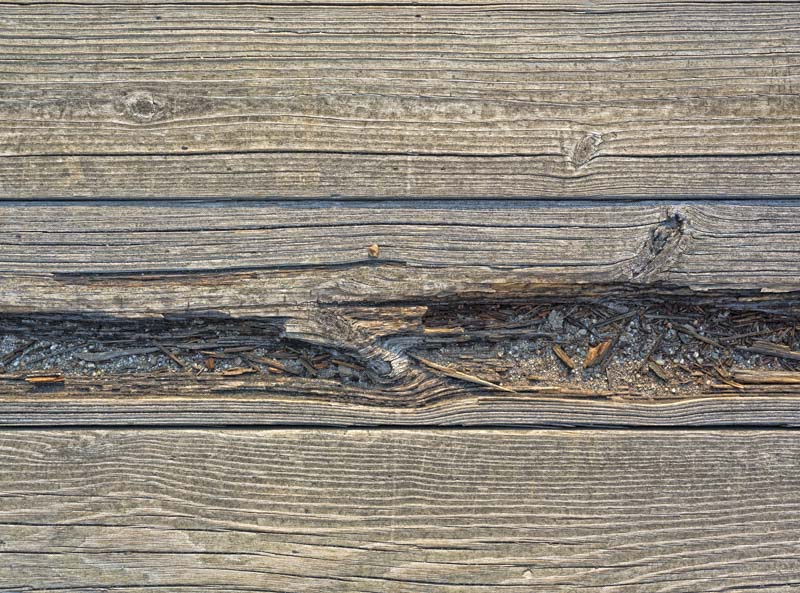
Various types of wood have different durability ratings, but most wood used outside your home won’t last more than 50 years, even with waterproofing.
Untreated wood can decay in just a few years when exposed to the elements. It can rot rather quickly depending on factors like the level of exposure, the type of wood, and the climate.
Waterproofing mainly protects wood against rot and decay because it prevents moisture damage. Waterproofing provides wood a critical defense against moisture by creating a barrier that repels water.
Resistance to Mold and Mildew
The organisms in nature responsible for breaking down organic matter don’t care if it’s the mulch in your garden, the leaves on your lawn, or the furniture in your yard.
Organisms like mold, mildew, moss, and lichen will grow on wood structures and furniture in your yard, especially if it’s not treated. Because these organisms need moisture to grow, they’re more likely to become established on untreated wood.
Mold and mildew are hard to remove from untreated wood without harsh chemicals like bleach or detergents. Chemicals like bleach further deteriorate the structure and integrity of the wood and impact its appearance and durability.
Many waterproofing products for wood have a mildewcide, but if not, you can always use an additive like Advanced Mildewcide with most waterproofing stains, paints, and coatings.
Maintains Wood’s Strength
Waterproofing wood helps it maintain its strength, and in some cases, it can even make it stronger. There are many different products and techniques used to waterproof wood, and some of them will add to the durability and tensile strength of the wood.
The end grain of wood soaks up moisture more easily, so if you’re trying to make wood stronger by waterproofing it, pay attention to sealing the ends and edges of boards.
Tips for Waterproofing Wood
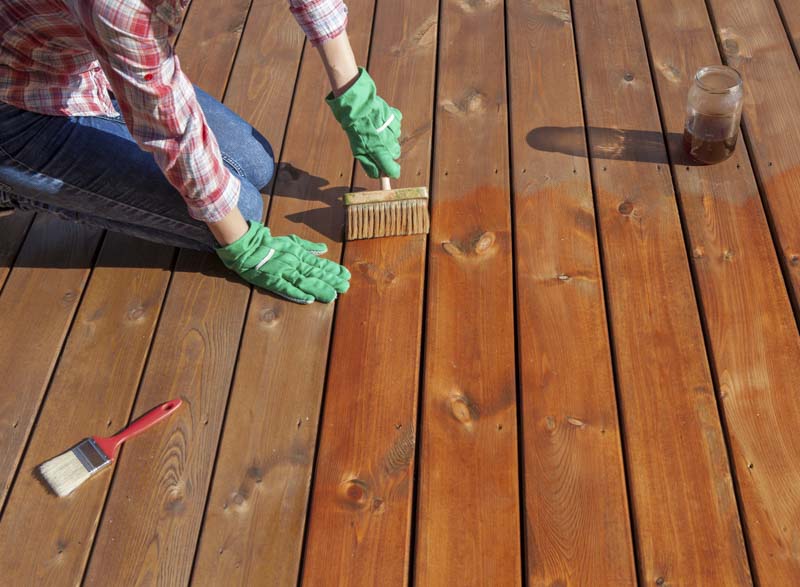
How you go about waterproofing wood depends on the project you’re working on and how you want it to look. To ensure the best results, follow these tips for waterproofing wood.
Choosing the Right Waterproofing Product
You can choose from many waterproofing products, including natural oils, stains, paints, urethane coatings, and epoxy sealers. To find the best waterproofing product for your project, consider the following factors:
- Wood type–Consider the wood’s strength, porosity, and natural beauty.
- Intended use–Many products are designed for indoor or outdoor use.
- Durability–Various waterproofing materials last longer than others.
- Ease of application–Choose the best product for your skill level.
- Appearance–The type of waterproofing product will influence the wood’s aesthetics.
- UV protection–Some materials provide better protection from ultraviolet rays.
- Mold resistance–An important consideration for humid environments.
- Drying time–This may be critical for some applications and climates.
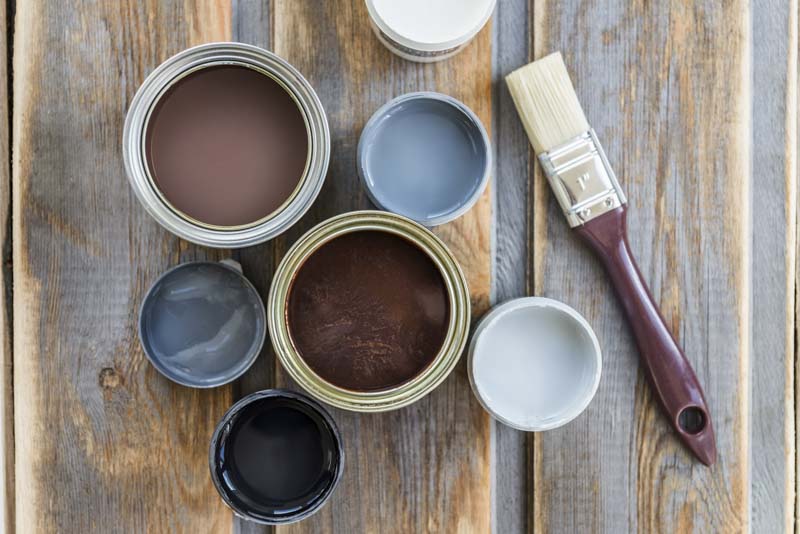
The following chart outlines the best way to waterproof wood depending on the type of project.
| Project | Best waterproofing materials |
| Water-based sealants like Thompson’s Water Seal oil-based water-repellent sealers | Natural stains for exterior use water-based spar urethane oil stains |
| Wood outdoor furniture | Exterior wood stains, sealers, and paints; Marine-grade varnishes and urethanes; Natural oil finishes like linseed oil |
| Wooden fences | Exterior wood stains and sealers |
| Exterior wood siding | Water-based sealants like Thompson’s Water Seal oil-based water repellent sealers |
| Wood structures, including gazebos, pergolas, outdoor kitchens | Water-based sealants like Thompson’s Water Seal oil-based water-repellent sealers |
| Indoor woodwork, including window frames and wood in kitchen and bathroom areas | Varnishes; Lacquers; Water-based and oil-based polyurethanes |
| Wood floors | Water-based and oil-based polyurethanes; Penetrating oil finishes |
| Wood in basement areas | Epoxy coatings; Rubberized foundation coatings for wood |
Surface Preparation
You must properly prepare wood surfaces before applying waterproofing materials. Otherwise, you risk improper adhesion, resulting in problems like peeling and flaking.
Start by cleaning the surface to remove dust and debris using a vacuum, broom, or dust cloth. Pressure washing is the best way to clean ingrained dirt and moss or algal growth on outdoor surfaces like fences and decks.
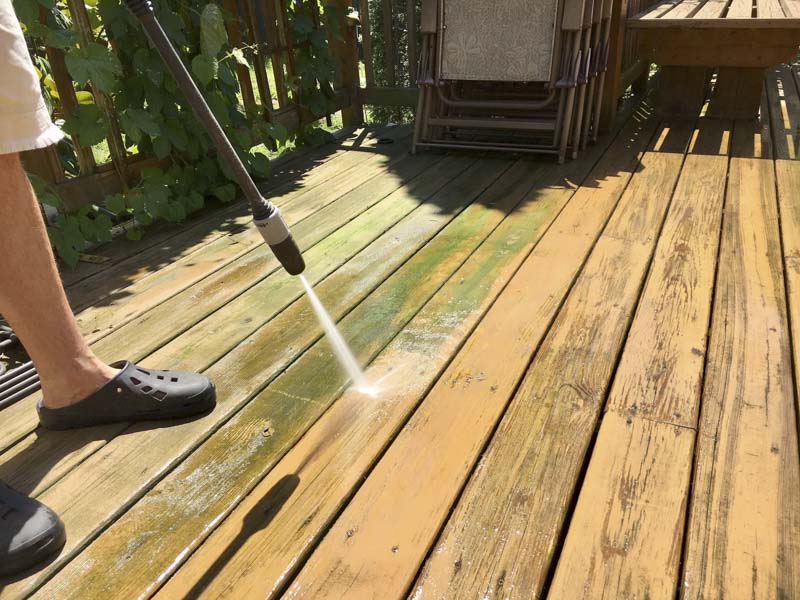
If there are any previous finishes, you must strip those using paint and varnish strippers, followed by sanding to condition the wood.
Applying a wood conditioner will help prevent blotchy or uneven staining. Wood conditioners make it easier to achieve a smooth finish, even on hard-to-stain wood types.
While on the topic of wood, learn more about pressure-treated lumber and what it is!
Proper Application Techniques
Various waterproofing materials for wood have different application techniques. Always refer to the manufacturer’s guidelines for the specific product you’re using.
You’ll generally want to go with the wood grain and use thin, even coats. When applying multiple coats, allow adequate time for each layer to dry.
Use natural bristle brushes for oil-based products and natural or synthetic ones for water-based materials. When using a rag, choose a lint-free cloth.
| Wood waterproofing material | Best application techniques |
| Clear deck sealers | Brush, roller, spray |
| Wood stains | Cloth or brush (bristle or foam) |
| Wood sealers | Brush or roller |
| Exterior paint | Brush, roller, spray |
| Varnishes | Brush or spray |
| Water-based polyurethane | Apply thin coats with a fine brush or cloth |
| Oil-based polyurethane | Brush, cloth, or spray |
| Natural oils | Cloth |
Maintenance and Reapplication
The amount of time a waterproofing product lasts depends on the type of wood, product type, and the conditions it’s subjected to. Outdoor projects need to be maintained more frequently.
Products like oil-based polyurethane may last up to ten years, especially in the parts of your home that don’t get much foot traffic. On the other hand, outdoor projects like patio furniture may need annual reapplication if you use a product like Thompson’s Water Seal.
The best way to seal wood for outdoor use is to use a natural oil finish, but you may need to reapply it two to three times each year. On the other hand, seals or stains only need to be reapplied every one to two years.
When to Waterproof Wood
Whether it’s a new project or an existing structure, learn when to waterproof wood.
New Wood Projects
Wait about three months after constructing a new project before you apply waterproofing. Wood needs to be completely dry before it will accept the waterproofing material, and most new lumber contains enough moisture that it won’t readily accept stains, sealers, and oils.
Existing Wood Structures
With existing wood structures, the easiest way to tell when to waterproof them is to use a water test. Pour or spray some water on the wood. If the water soaks into it, it’s time to apply a waterproofing product. If the water beads up on the surface, the existing sealant is doing its job.
It’s also important to plan around the weather when you’re waterproofing stained wood outdoors. Ideally, you want to avoid rain for a few days while the product dries. The best temperature for waterproofing wood is 60° to 65°F (15° to 18°C).
Additional Considerations When Waterproofing Wood
Here are a few other factors to consider when you’re waterproofing wood.
Environmental Impact
People are increasingly paying closer attention to the environmental impact of the products they choose. While traditional lumber waterproofing materials are chemical-based products with harmful volatile organic compounds (VOCs), many eco-friendly products are available.
Water-based products are generally less harmful to the environment than oil-based products. However, they also have to be applied more frequently, so there is some trade-off. The biggest advantage of using water-based products is that cleanup is much easier and doesn’t require paint thinners or solvents.
Natural oils are the most eco-friendly choice for water-sealing wood. They’re renewable, biodegradable, and don’t have any VOCs. While you have to reapply them more frequently, they are easier to apply, and cleanup is minimal.
Safety Precautions
Prioritize safety whenever you’re DIYing a home improvement project. Some products used for waterproofing lumber are high in VOCs and may be flammable.
It’s usually best to work outdoors under cover, but use proper ventilation and safety gear if you have to work indoors. Keep materials from open flames and follow the manufacturer’s safety guidelines for storage, application, and disposal.
Cost Analysis
Most homeowners consider the cost of products when choosing the right materials for waterproofing wood around their home. However, it’s important to consider upkeep and maintenance when conducting a project cost analysis.
Another factor you’ll want to consider is how long the product lasts. Quality products are more expensive, but you don’t have to reapply them as often, and they protect the wood better.
Ease of application is another factor worth consideration, especially if you’re paying someone to apply the materials.
Frequently Asked Questions about How to Waterproof Wood
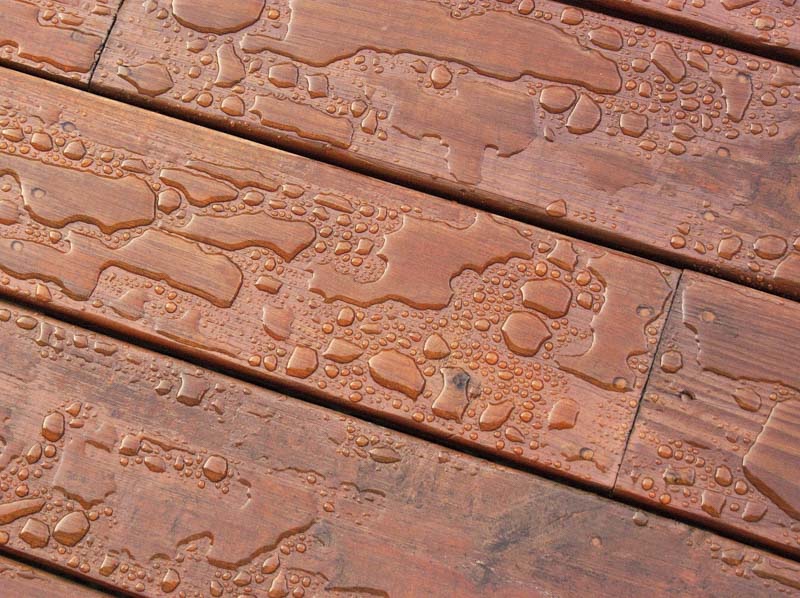
What is the best waterproofing product for outdoor wood furniture?
Waterproofing wood furniture protects your investment. The best way to waterproof wood furniture depends on the type of wood, the aesthetic you’re trying to achieve, and your climate.
Generally, exterior wood stains, sealers, paints, marine-grade varnishes and urethanes, and natural oil finishes like linseed oil work well for outdoor furniture. Many people prefer natural oils because they are less toxic.
Can you waterproof wood without changing its appearance?
Natural oils, including linseed, tung oil, and Danish oil, are some of the best waterproofing materials to maintain the wood’s appearance. When you use penetrating oils on wood, rather than varnish or polyurethane, you don’t have to worry about discoloration, and it’s easy to reapply.
How often should I reapply waterproofing to my deck?
It depends on the level of exposure your deck gets, but most experts recommend reapplying waterproofing products every few years. In some climates, you may need to do it yearly for maximum water protection for wood.
Is waterproofing necessary for indoor wood surfaces?
Waterproofing interior wood surfaces is necessary if the wood is exposed to moisture. Some of the most common indoor wood surfaces that need protection include hardwood floors, window frames, and kitchen or bathroom cabinets.
Already have wood floors but they need work? Learn how much it costs to refinish hardwood floors with our comprehensive guide!
What are the differences between oil-based and water-based waterproofing products?
Oil- and water-based stains, sealers, and polyurethanes are readily available and provide excellent waterproofing for wood. The main difference is in the cleanup. Also, oil-based products contain more VOCs.
Another factor to consider with polyurethane is that while oil-based poly is more durable, it will yellow over time, while water-based poly stays clear.

